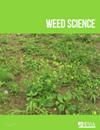Implications of climate change for environmental niche overlap between five Cuscuta pest species and their two main Leguminosae host crop species
IF 2.1
2区 农林科学
Q2 AGRONOMY
引用次数: 3
Abstract
Abstract Some parasitic plants are major pests in agriculture, but how this might be affected by climate change remains largely unknown. In this study, we assessed this question for five generalist holoparasitic Cuscuta species (smoothseed alfalfa dodder [Cuscuta approximata Bab.], alfalfa dodder [Cuscuta europaea L.], soybean dodder [Cuscuta chinensis C. Wright], Peruvian dodder [Cuscuta australis R. Br.], and Japanese dodder [Cuscuta japonica Choisy]) and two of their main Leguminosae host crop species (soybean [Glycine max (L.) Merr.] and alfalfa [Medicago sativa L.]. For each of the five Cuscuta species and the two crop species, we ran MaxEnt models, using climatic and soil variables to predict their potential current distributions and potential future distributions for 2070. We ran species distribution models for all seven species for multiple climate change scenarios, and tested for changes in the overlap of suitable ranges of each crop with the five parasites. We found that annual mean temperature and isothermality are the main bioclimatic factors determining the suitable habitats of the Cuscuta species and their hosts. For both host species, the marginally to optimally suitable area will increase by 2070 for all four representative concentration pathway scenarios. For most of the Cuscuta species, the marginally to optimally suitable area will also increase. While the suitable areas for both the hosts and the parasites will increase overall, Schoener's D, indicating the relative overlap in suitable area, will change only marginally. However, the absolute area of potential niche overlap may increase up to 6-fold by 2070. Overall, our results indicate that larger parts of the globe will become suitable for both host species, but that they could also suffer from Cuscuta parasitism in larger parts of their suitable ranges.气候变化对五种菟丝子害虫及其两种主要豆科寄主作物之间环境生态位重叠的影响
摘要一些寄生植物是农业中的主要害虫,但气候变化如何影响这种害虫在很大程度上仍然未知。在这项研究中,我们评估了五种全寄生菟丝子(光滑种子苜蓿菟丝子[Cuscuta approximata Bab.]、苜蓿菟丝儿[Cuscutta europaea L.]、大豆菟丝子[Ccuscuta chinensis C.Wright]、秘鲁菟丝子[Bcuscuta australis R.Br.]和日本菟丝子[Dcuscuta japonica Choisy])及其两种主要豆科寄主作物(大豆[Glycine max(L。)Merr.]和苜蓿。对于五种菟丝子和两种作物中的每一种,我们都运行了MaxEnt模型,使用气候和土壤变量来预测它们在2070年的潜在当前分布和潜在未来分布。我们对多种气候变化情景下的所有七个物种运行了物种分布模型,并测试了每种作物与五种寄生虫的适宜范围重叠的变化。我们发现,年平均温度和等温性是决定菟丝子及其寄主适宜生境的主要生物气候因素。对于这两种宿主物种,在所有四种具有代表性的浓度途径情况下,边际至最佳适宜面积将增加2070。对于大多数菟丝子物种来说,边缘到最佳合适的面积也会增加。虽然宿主和寄生虫的合适区域总体上都会增加,但Schoener的D表示合适区域的相对重叠,只会略有变化。然而,到2070年,潜在生态位重叠的绝对面积可能会增加6倍。总的来说,我们的研究结果表明,全球更大的地区将适合这两种宿主物种,但它们也可能在更大的适合范围内遭受菟丝子寄生。
本文章由计算机程序翻译,如有差异,请以英文原文为准。
求助全文
约1分钟内获得全文
求助全文
来源期刊

Weed Science
农林科学-农艺学
CiteScore
4.60
自引率
12.00%
发文量
64
审稿时长
12-24 weeks
期刊介绍:
Weed Science publishes original research and scholarship in the form of peer-reviewed articles focused on fundamental research directly related to all aspects of weed science in agricultural systems. Topics for Weed Science include:
- the biology and ecology of weeds in agricultural, forestry, aquatic, turf, recreational, rights-of-way and other settings, genetics of weeds
- herbicide resistance, chemistry, biochemistry, physiology and molecular action of herbicides and plant growth regulators used to manage undesirable vegetation
- ecology of cropping and other agricultural systems as they relate to weed management
- biological and ecological aspects of weed control tools including biological agents, and herbicide resistant crops
- effect of weed management on soil, air and water.
 求助内容:
求助内容: 应助结果提醒方式:
应助结果提醒方式:


